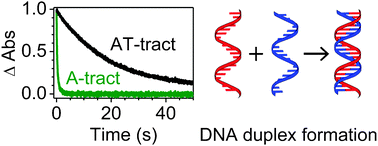Kinetics of DNA duplex formation: A-tracts versus AT-tracts†
Abstract
The hybridisation and melting of DNA strands are critical steps in many biological processes, but still a deeper understanding of the kinetics is lacking. This is evident from the absence of a clear correlation between rate constants for duplex formation and the number of bases in the strand or the sequence. Here we have probed differences between formation times of A-tracts and AT-tracts by studying complementary model strands mainly comprised of adenine (A) and thymine (T) in stopped-flow (SF) experiments. These strands are relevant as DNA replication begins in regions with a large number of AT base pairs. Interpretation of our results is aided by secondary-structure modelling where both the fractions of the different types of structures and the number of paired bases in the lowest-energy ones are determined. The model is based on calculation of free energies using fixed values for enthalpies and entropies associated with base pairing and a stochastic sampling of the possible structures. We find that the strand length affects rates: the activation energy for the formation of short (16-base pairs) A-tracts is larger than that for longer ones (20-base pairs). Activation energies for the formation of AT-tracts are an order of magnitude larger, and larger for shorter strands than for long ones. These higher activation energies are in agreement with the fact that the fraction of unpaired bases in the constituent AT-tract strands is less than in those which comprise the A-tracts. That the pre-structures of the single strands significantly affect rates is also used to rationalise the results obtained for two pairs of complementary 12-mer strands that have the same bases but in a different sequence; we report here similar activation energies as reported earlier and that these are strongly sequence dependent. Finally, we demonstrate that SF can be coupled with the measurement of circular dichroism (CD) in the vacuum ultraviolet (VUV) region, taking advantage of a synchrotron radiation facility, and that CD is useful to probe geometrical structures in the VUV where the absorption by DNA is high. Though this work is preliminary, our initial results suggest that the strands align prior to the formation of base pairs.


 Please wait while we load your content...
Please wait while we load your content...